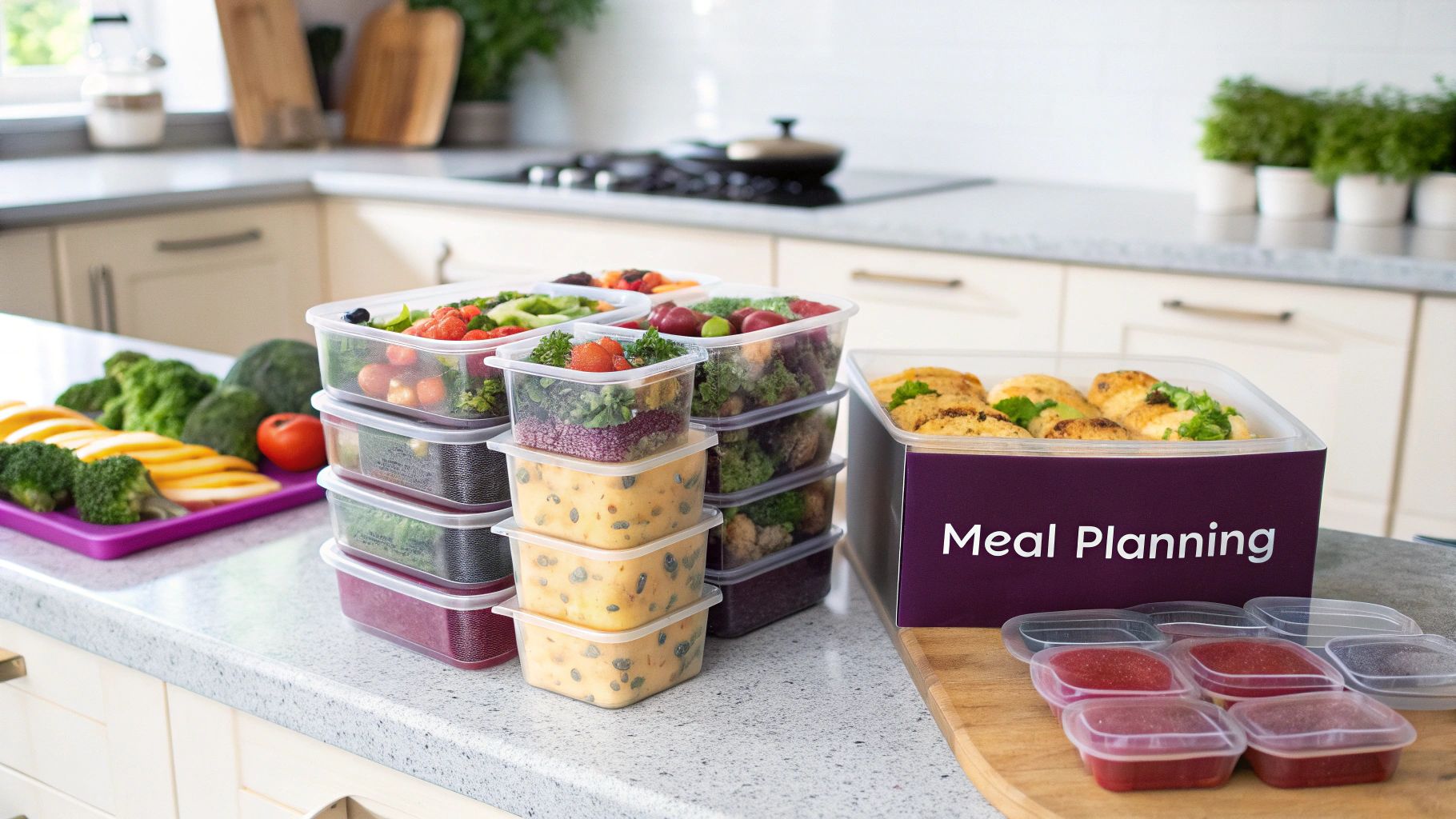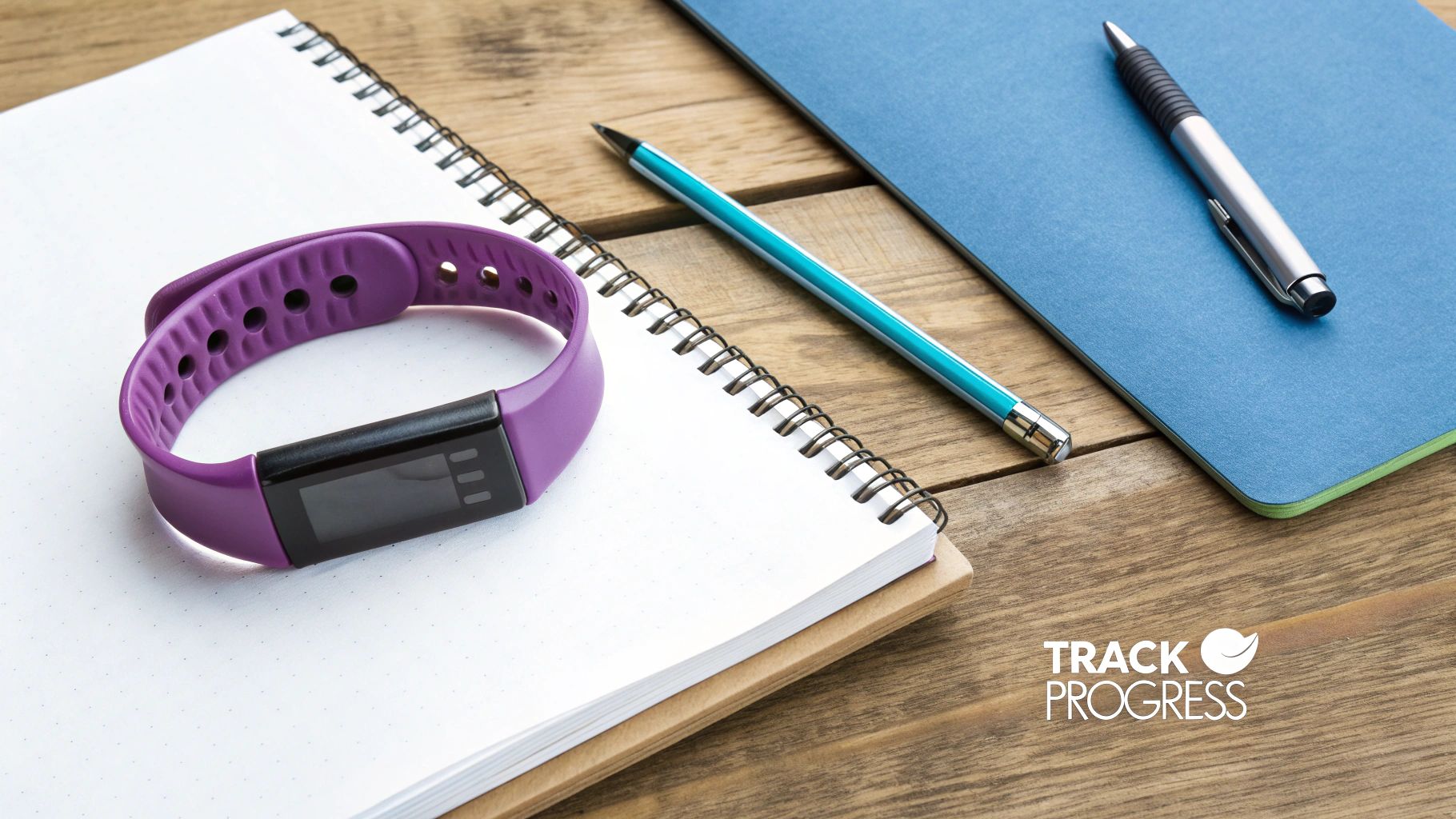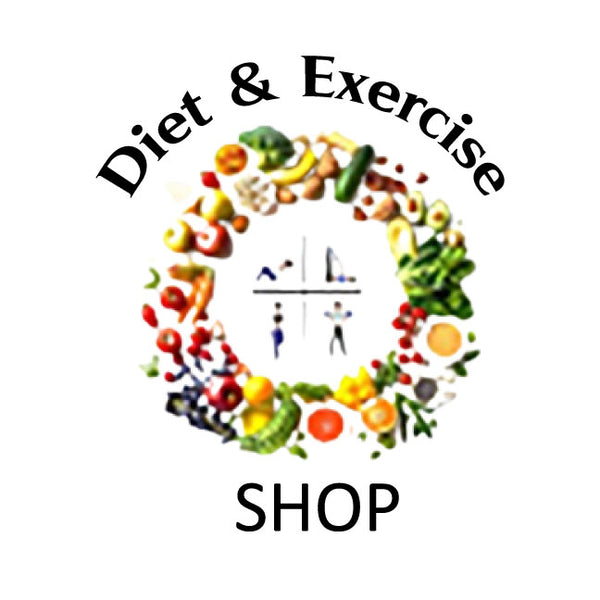
Your Guide to a Diet and Exercise Plan That Works
A solid diet and exercise plan is your personal roadmap to health. It's a specific combination of nutrition and physical activity designed to help you hit your fitness goals.
This moves you beyond generic advice and into a sustainable structure that actually fits your body, your schedule, and your life.
Why Generic Plans Fail and Personalization Succeeds

One-size-fits-all fitness plans often lead to frustration and burnout. They promise quick results but fail because they ignore the most important variable: you.
These cookie-cutter programs don't consider your unique metabolism, work schedule, food preferences, or starting fitness level. A plan for a 25-year-old athlete won't work for a 45-year-old office worker.
The Power of a Tailored Approach
A personalized plan is built around your life and your specific goals, whether it's weight loss, muscle gain, or increased energy. When a plan is designed for you, sticking with it feels achievable.
Lasting success comes from understanding your body. This means looking beyond the scale and paying attention to your body composition—the ratio of fat to muscle—which is a more accurate measure of health.
To truly understand these metrics, you need the right tool. Our Smart Body Fat Scale provides detailed data on 13 key metrics, including muscle mass and body fat percentage, syncing directly to your phone to track your real progress.
Building a Plan That Lasts
A successful strategy is one you can maintain long-term. It's about smart, sustainable choices, not extreme restrictions.
If you dislike running, your plan shouldn't include marathon training. Instead, it should feature activities you enjoy, like hiking, dancing, or lifting weights.
The best diet and exercise plan isn't the toughest one. It's the one you can stick with day in and day out. Consistency, not intensity, is what delivers real results.
The same principle applies to your diet. A personalized eating plan includes foods you genuinely like, turning healthy eating into an enjoyable habit. You'll learn to fuel your body effectively, making food your greatest ally.
Defining What Success Looks Like for You
Before you start, you must define what you're trying to accomplish. Vague goals like "get fit" or "be healthier" lack direction and make it hard to track progress.
What does success look like for you? Is it losing 15 pounds? Benching your body weight? Or finishing your first 5K? Be specific. Your goal is your north star.
Moving Beyond Vague Aspirations
Let's turn a common goal like "I want to tone up" into something actionable. "Toning up" can mean losing body fat to reveal muscle or simply feeling stronger.
A much better goal is: "My goal is to lower my body fat by 5% and be able to do 10 consecutive push-ups in the next three months." This gives you a clear target, a measurable outcome, and a deadline.
This visual shows how a consistent routine powers you toward tangible results.

As the infographic suggests, a structured plan is the core component that drives the physical changes you're working for. Use the framework below to turn your fitness wishes into a real, actionable plan.
Turning Vague Fitness Goals into an Actionable Plan
Use this framework to define your fitness objectives with clarity, making them easier to track and achieve.
| Common Goal | Specific Objective | How to Measure It | Actionable First Step | Realistic Timeframe |
|---|---|---|---|---|
| "Get stronger" | I want to deadlift 225 lbs for 5 reps. | Log my workouts and track the weight I lift each week. | Find a beginner strength program and go to the gym 3x this week. | 4-6 months |
| "Lose weight" | I want to lose 10 lbs of body fat. | Weigh myself weekly and track body fat percentage once a month. | Plan and prep my lunches for the next 5 days. | 2-3 months |
| "Improve endurance" | I want to run a 5K race without stopping. | Use a running app to track my distance and time. | Start a "couch to 5K" program tomorrow morning. | 8-12 weeks |
| "Be healthier" | I want to eat 5 servings of vegetables daily and walk 10,000 steps. | Use a habit tracker app and a step counter on my phone. | Go for a 20-minute walk after dinner tonight. | Ongoing |
Tracking Progress the Right Way
Once your goals are clear, you need a smart way to measure progress. A traditional scale can be misleading because it doesn't differentiate between fat loss and muscle gain.
You need better data. Focus on these key areas:
- Body Composition: Track the breakdown of fat, muscle, and water. Seeing muscle mass increase while body fat decreases is a huge win. The Smart Body Fat Scale is perfect for this, offering precise measurements of 13 key health metrics.
- Performance Metrics: Keep a log. Are you lifting heavier, doing more reps, or running faster? These numbers prove you're getting fitter.
- Progress Photos: Take pictures every 2-4 weeks. They reveal gradual changes you might miss by just looking in the mirror.
Relying only on total body weight is like judging a book by its cover. True success is measured by changes in strength, energy, and body composition.
For tips on making fitness a permanent part of your life, visit the Diet & Exercise YouTube channel. By setting clear goals and tracking them with the right tools, you create a powerful feedback loop for success.
Building Your Workout Schedule for Maximum Impact

Now it's time to build your routine. A great workout schedule is a deliberate plan built to achieve your specific goals efficiently.
A solid diet and exercise plan is built on three pillars: cardiovascular exercise, strength training, and flexibility work. Skipping one will make your plan unstable in the long run.
How to Structure Your Week: Finding Your Workout Split
Your "workout split" is how you organize your workouts. The best split fits your life, goals, and current fitness level.
If weight loss is your goal, you'll want more cardio. For building muscle, strength training is key. The most important thing is creating a schedule you can stick to.
Here are a few common splits:
- The 3-Day Foundation: A great starting point with full-body workouts in each session.
- The 4-Day Push/Pull: Divides training by "pushing" exercises (like push-ups) and "pulling" exercises (like rows).
- The 5-Day Body Part Split: Dedicates each workout to a specific muscle group (e.g., chest day, leg day).
For beginners, our guide on workout routines for beginners at home offers simple templates.
The Three Pillars of a Balanced Routine
An effective plan includes all three of these components.
1. Strength Training
This is non-negotiable for building lean muscle, boosting your metabolism, and strengthening bones. Aim for 2-4 strength sessions per week, with at least one rest day for each muscle group.
Your muscles don't grow in the gym; they grow during recovery. Rest is just as important as the work itself.
2. Cardiovascular Exercise
Cardio is essential for heart health, stamina, and burning calories. Aim for 150 minutes of moderate-intensity cardio each week.
3. Flexibility and Mobility
This is your body's insurance against injury. Just 5-10 minutes of stretching after workouts improves range of motion and eases muscle soreness.
Gearing Up for At-Home Success
You don't need a gym membership. With a few key pieces of equipment, you can create an effective home workout space.
Our Adjustable Dumbbell Set is a space-saving solution that replaces an entire rack of weights, allowing you to easily increase resistance as you get stronger.
A versatile Resistance Bands Kit is another excellent tool. Bands are perfect for targeting smaller stabilizer muscles, warming up, and adding challenge to bodyweight exercises. See them in action in this resistance band demonstration on the Diet & Exercise YouTube channel.
Designing a Diet That Fuels Your Body and Mind
You can't out-train a bad diet. The food you eat powers your workouts, repairs muscles, and keeps you sharp. Your nutrition is your greatest ally.
An effective diet and exercise plan is built on simple, sustainable habits with whole foods.
Fueling for Your Goals
Your diet should directly support your goals. It all starts with calories—the energy your body runs on.
Use an online calorie calculator for a baseline, then fine-tune your macronutrients: protein, carbs, and fats.
- Protein: Essential for muscle repair. Aim for 0.7-1.0 grams per pound of body weight if you're strength training.
- Carbohydrates: Your body's main energy source for workouts.
- Fats: Healthy fats from avocados, nuts, and olive oil are vital for hormone production.
Making Healthy Eating Simple
The key is to make the healthy choice the easy choice. A little prep goes a long way.
Your post-workout meal is crucial. For about 30-45 minutes after a workout, your body is primed to absorb nutrients for recovery. A quick protein shake is a perfect solution.
Don't let complicated recipes get in the way. A quick, nutrient-dense smoothie is the perfect answer for busy days and that crucial recovery window.
Our High-Speed Smoothie Blender makes this effortless. It creates a perfect recovery shake in seconds, so you never miss that critical refueling opportunity. Get tasty ideas on our Diet & Exercise YouTube channel.
Meal Prepping for Success
Meal prepping is your secret weapon against bad food choices. Dedicate a couple of hours one day a week to cook and portion your meals.
This eliminates guesswork and decision fatigue, ensuring a healthy option is always ready. You can read more about modern nutrition trends at the Global Wellness Institute.
Good containers are essential for a smooth process. Our Meal Prep Container Sets are durable, leak-proof, and perfectly portioned to keep you on track.
Sample Meal Ideas for a Balanced Day
Here are a few simple meal ideas built on whole foods.
Breakfast:
- Scrambled eggs with spinach and whole-wheat toast.
- Greek yogurt with berries and nuts.
Lunch:
- A big salad with grilled chicken and light vinaigrette.
- Quinoa bowl with black beans, corn, and avocado.
Dinner:
- Baked salmon with roasted asparagus and a sweet potato.
- Lean turkey stir-fry with broccoli and brown rice.
Healthy Snacks:
- An apple with almond butter.
- A small handful of almonds.
- Baby carrots with hummus.
Weaving in Habits That Actually Guarantee Long-Term Success
The secret to lasting results is the small, consistent habits you build.
Things like sleep and hydration are the glue holding your plan together. These non-negotiables will make or break your success.
Hydration: The Overlooked Performance Enhancer
Proper hydration is one of the most powerful tools in your arsenal. Water is critical for energy, strength, and metabolism.
Even mild dehydration can lead to fatigue, headaches, and sugar cravings that derail your goals.
If you forget to drink water, our Smart Water Bottle can help. It tracks your intake and sends gentle reminders, so you hit your daily goals effortlessly.
Sleep: Your Ultimate Recovery Tool
If you're skimping on sleep, you're spinning your wheels. Sleep is when your body repairs muscle and regulates the hormones that control appetite and stress.
Poor sleep leads to cravings and fat storage.
Think of sleep as the non-negotiable reset button. Getting 7-9 hours of quality sleep is just as important as any workout or meal.
A relaxing bedtime routine can improve sleep quality. Shut down screens an hour before bed and create a calm sanctuary. An Aromatherapy Diffuser with lavender can signal to your brain that it's time to relax, helping you get the deep rest you need.
Managing Stress to Protect Your Progress
Chronic stress can kill your progress. It floods your body with cortisol, which can lead to muscle breakdown and increased fat storage.
Finding healthy ways to manage stress is an absolute necessity.
Try these simple strategies:
- Mindful Movement: A quiet walk or gentle stretching can calm your nervous system.
- Deep Breathing: Five minutes of slow, deep breathing can lower cortisol. Find a simple guided exercise on our Breathing Technique Video.
- Journaling: Get your thoughts on paper to process emotions and clear your mind.
Answering Your Top Diet and Exercise Plan Questions
Feeling uncertain when starting a new diet and exercise plan is normal. Let's tackle some common questions.
How Long Until I Actually See Results?
You'll likely feel better within a week or two, but visible physical changes take longer.
Generally, it takes about 4 to 8 weeks of consistent work to see noticeable progress. Be patient. The real win is building sustainable habits.
I Missed a Workout (or Ate a Whole Pizza)... Now What?
Don't panic. One off-plan meal or skipped workout won't undo your hard work. Avoid the "all-or-nothing" trap.
A single slip-up is just a blip on the radar, not a total failure. Your long-term success is built on what you do most of the time.
The best response is to get right back on track with your next planned meal or workout.
How Often Do I Need to Change My Plan?
Your body adapts, so you need to shake things up to avoid plateaus. Review and tweak your plan every 4 to 6 weeks.
This doesn't mean a complete overhaul. Small changes like lifting heavier, trying new cardio, or adjusting your calorie targets are often enough.
Is It Possible to Lose Fat and Build Muscle at the Same Time?
Yes, this is called "body recomposition," and it's especially effective for those new to lifting.
You need to eat enough protein in a slight calorie deficit and prioritize challenging strength training. It’s a slower process, but it delivers a complete physique change. Learn more in this video on body recomposition from the Diet & Exercise YouTube channel.
At Diet & Exercise, we know that having the right equipment can make all the difference. From comfortable workout clothes to the home gym gear that keeps you going, we’ve got what you need to support your new lifestyle. Find the tools to help you crush your goals by visiting our official shop.
